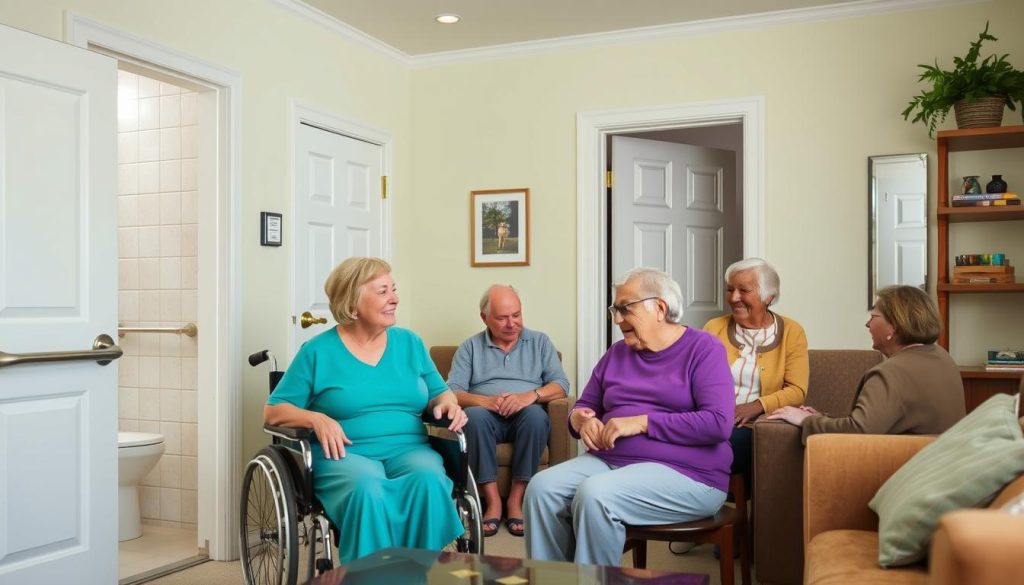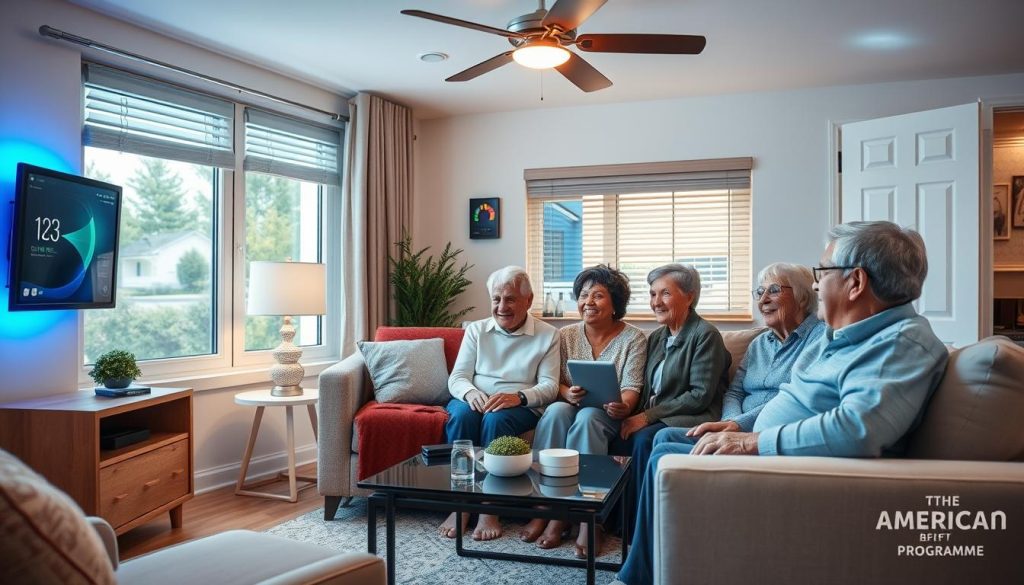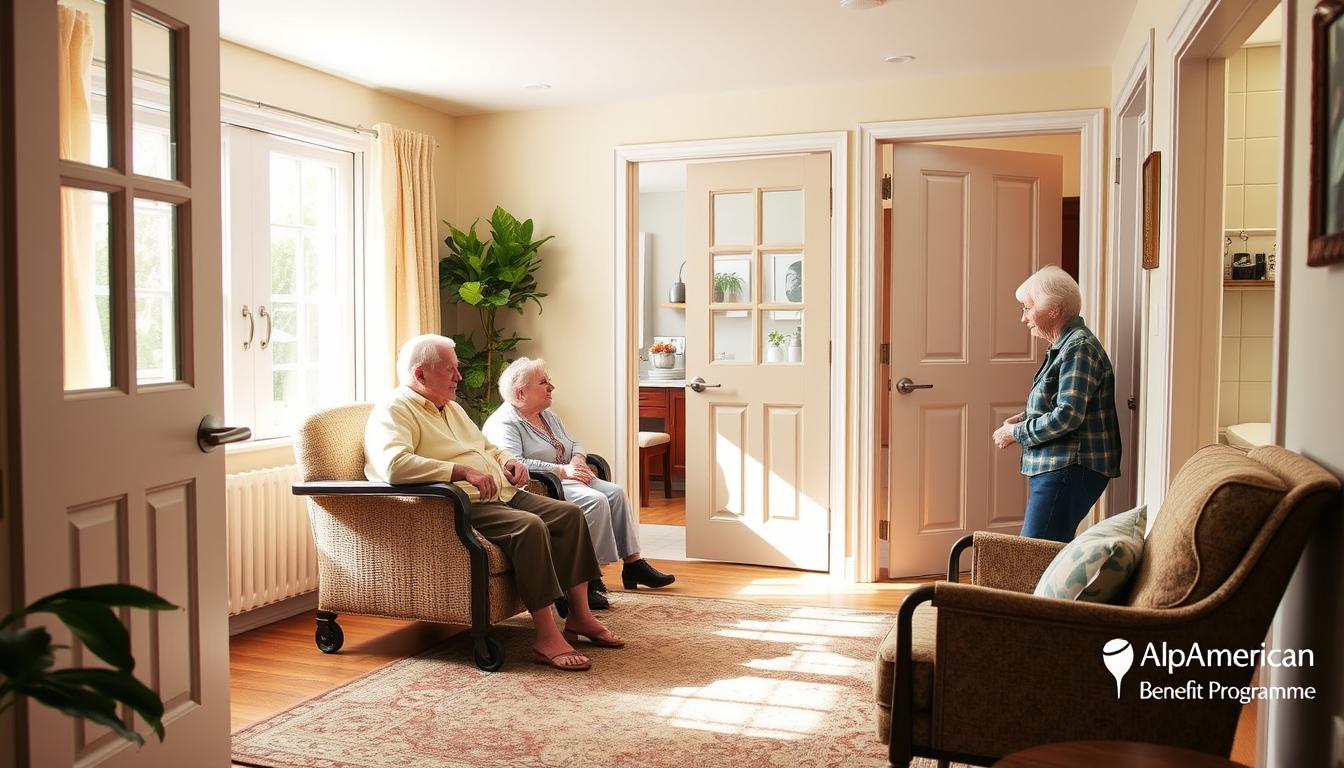Have you ever thought about why 77% of Americans over 50 want to stay home1? They choose this for comfort, independence, and the love for their home. This guide talks about key home changes for seniors. These changes make their home safe and welcoming.
We’ll look at easy fixes like handrails and grab bars. And bigger changes like ramps and floors that don’t slip. These fixes help with common aging problems, such as less mobility and strength.
We also discuss costs, which can be $150 to $2,000, and how to pay for these upgrades2. We want every senior to have a safe, comfy home as they get older.
Key Takeaways
- 77% of older adults prefer aging in place over relocation.
- Simple modifications enhance safety and comfort at home.
- Home modifications can range between $150 and $2,000.
- Several financial assistance programs are available to support home renovations.
- Hiring licensed professionals ensures quality and safety in modifications.
Understanding the Need for Home Modifications
As seniors get older, it gets harder for them to move around their homes. They might find stairs tough and cabinets too high. About 40% of Americans over 65 have trouble moving. That’s why making homes easier to use is so important3. By changing homes to better fit their needs, families keep their loved ones safe and comfy.
The National Home Safety Group focuses on making these changes. They want to make sure home changes fit the needs of the elderly and disabled3. Experts like therapists and builders make these changes happen. They work together to make homes safe and better for seniors.
There’s also money help like the Older Adults Home Modification Grant. It gives $30 million to help low-income seniors4. This money goes to things like grab bars and easy-to-use doorknobs. The aim is to lower the chance of falling, keep seniors safe, and let them enjoy their homes longer.
Benefits of Aging in Place Modifications
Getting older doesn’t have to mean giving up independence or quality of life. Changes made to a senior’s home can keep them safe and reduce worries about getting hurt. For example, making bathrooms safer with grab bars and non-slip mats5 is key. These steps help right away by preventing falls.
They also make seniors feel more secure. This lets them do their daily activities without fear.
Making homes easier to live in is another great move. Widening doors and lowering countertops helps a lot6. This is especially useful for those who use wheelchairs or walkers. Plus, many seniors get help at home from family or professional caregivers7. A safer home is good for everyone involved.
Thinking about costs is important too. Thankfully, there are resources like Medicare and community programs to help pay for changes5. Small updates, such as adding ramps or improving lights, make a big difference. They help seniors stay in their homes safely, avoiding bigger problems and costs later6.
But it’s not just about avoiding accidents. Being able to stay in a familiar home is good for a senior’s mental and emotional health7. It helps them stay connected to their community and family. Making these changes means a happier, more independent life for older adults.
Evaluating Your Current Home Setup
A detailed home evaluation for seniors is crucial before starting any home improvement projects. Start by checking each room for safety issues and areas that might need changes. Focus on the bathroom and kitchen first, since small changes there can help a lot8. Studies show most older people want to stay in their homes as long as they can. This shows why early and regular checks are important9.
Checklists are a big help for seniors and those taking care of them. Plumbers or handymen, charging between $60 and $125 an hour, can fix problems found9. Working together on this ensures that the home becomes safer and more comfortable over time, experts agree8 and9.
Look at how easy it is to use kitchen cabinets and bathroom items10. Make sure the lighting is good and check the whole house for trip hazards10. These steps make a home better suited for senior living.
| Area of Evaluation | Key Features to Assess | Considerations |
|---|---|---|
| Kitchens | Cabinet height, ease of access, water temperature safety | Adjust shelving for convenience, ensure accessibility of appliances |
| Bathrooms | Grab bars, toilet height, tub accessibility | Incorporate non-slip surfaces for safety, evaluate tub/shower setup |
| Lighting | Brightness levels, placement of night-lights | Enhance brightness in dim areas, ensure clear visibility for all rooms |
| Living Areas | Furniture arrangement, space for mobility aids | Keep pathways clear to prevent falls, evaluate chair heights |
Common Accessibility Modifications for Seniors
Making changes to a home can greatly help seniors live better. Many older adults have trouble moving around. Making their homes easier to use and safer is key. Different options exist to fit their needs.
Handrails and Grab Bars
Putting in handrails and grab bars makes a house safer. They help prevent falls, especially near stairs and bathrooms. It costs about $100 to $500 to add each one. This makes it a good way to make homes fit for seniors11.
Their installation in hallways and bathrooms helps seniors feel more secure. It lets them move around their homes on their own.
Ramps and Stair Lifts
Ramps and stair lifts let older people move between floors easily. Wheelchair ramps cost about $1,000 to $4,000. Stair lifts vary in price from $1,500 to $5,00011. These changes lower the chance of getting hurt and help those who use wheelchairs or walkers.
Adding ramps and stair lifts makes homes welcoming for seniors. It greatly improves their everyday life.

Bathroom Modifications: Making a Safer Space
Bathrooms can be tricky for older people because of wet floors and risky layouts. Making some changes can really help. By adding non-slip floors and grab bars, we make it safer and more comfortable.
Non-Slip Surfaces and Grab Bars
Putting in floors that don’t slip is key. Rubber floors or special vinyl make falling less likely. About 80% of falls happen in the bathroom12. Grab bars next to the toilet and in the bath help a lot, too. They make it easier to stay balanced13. Most older folks fix up their homes to stay safe14.
Walk-in Tubs and Curbless Showers
Walk-in tubs are great. They have low sides and seats inside. This makes bathing safe and easy13. Showers without edges are also good. They stop trips because there’s nothing to step over13. Many older people want to stay in their homes. Making it easier to get around helps a lot14. Making these bathroom changes is key to staying safe and independent.
Kitchen Adjustments for Senior-Friendly Use
The kitchen can be hard for seniors because of how it’s usually made. Making some changes can really help make the kitchen better for older people. For example, making doorways wider, at least 36 inches, helps with wheelchair access15. Also, it’s good to have more space, at least 48 inches, between wall cabinets and the island for people with walkers15.
Adding things like shelves that pull down can make reaching stuff easier. Using induction cooktops is safer because they heat up fast and are flat16. Also, installing hands-free faucets that prevent burns is key for those who can’t move well15.
For the floor, hardwood is a top choice since it’s softer and cuts down on fall risks15. Good lighting matters a lot, especially for those with bad eyesight. Track lights or lights that turn on by themselves can make the kitchen safer and easier to use17. Spending money on shelves that are easy to reach can range from $300 to $1,20016.
| Item | Price Range | Recommendation |
|---|---|---|
| Touchless Trash Cans | $45 and above | Easy disposal for limited mobility |
| Drawer Dishwashers | $900 – $2,000 | Designed for accessibility |
| Induction Cooktops | Twice as much as electric | Safer cooking option |
| Track or Motion-Detecting Lights | Varies | Enhances kitchen safety |
About 87% of seniors want to stay in their homes as they age17. Simple changes in the kitchen can help them stay independent. This lets them keep cooking and preparing food safely and easily.
Living Room and Bedroom Accessibility
Making homes safe and cozy for older adults is key, especially in living rooms and bedrooms. Furniture should be easy to use and move around. This keeps daily activities smooth and lowers the chance of falls. Most seniors, as AARP found, wish to stay in their homes as they age. This shows why making homes easy to live in matters a lot18.
To help seniors move around easily, arrange furniture to create plenty of space. Doors should be wide, at least 36 inches, for better access and freedom. This is especially true for those in wheelchairs18. In bedrooms, the right bed height helps seniors get in and out easily. Also, floors should be safe for walking or using a wheelchair19.
Good lighting is important to avoid falls. Putting night lights in bedrooms and hallways makes moving around safer at night18. Skip the throw rugs to reduce tripping risks. Doors should have peepholes or windows at the right height. This lets seniors see who’s there without having to stretch19.
Since 26% of falls occur in the bedroom, it’s important to make changes that reduce risks18. Adding grab bars near the bed and in key places offers needed support. Bad lighting in old homes can make it hard for seniors to see. It’s crucial to improve lighting to help them move around safely20.
Home Modification for Seniors: Costs and Budgeting
Seniors want to keep living at home as they get older. The cost of making home changes varies a lot. It depends on what work is needed.
Average Costs of Common Modifications
AARP says many seniors don’t want to leave their homes. Making some changes is important. Small adjustments like wider doorways might be cheap, under $100. But, big changes, like a ramp, can be $1,000 to $4,00021.
Costs for fixing up a home changes a lot. Small jobs might be $150 to $2,000. Bigger ones can go over $50,000. Putting in floors that don’t slip is key22. They prevent falls, especially in bathrooms. These floors can be pretty cheap, less than $3 for each square foot.
Finding Financial Assistance Programs
Seniors looking for help to pay for home fixes have options. Contractors might offer discounts. Some fixes might even cut your taxes22. Groups like the USDA and HUD give grants and loans. Knowing about these can really help make homes safer for seniors.
Hiring Professionals for Home Modifications
Getting the right help for home changes is important. Some tasks can be DIY, but others need experts. This ensures everything meets safety rules and building codes. That’s why finding contractors is needed.
Choose pros who are licensed and know how to help older people’s homes. These experts make sure your home is safe and works well. Ask your family and friends for contractor suggestions. They might know good ones.
You can also look at local directories and review websites for contractor ideas. Once you have a few names, ask them about their work and if they specialize in helping older adults. Finding someone with the right skills gives you peace of mind.
After picking a contractor, getting their plan in writing is key. This plan should list prices, what will be done, and how long it will take. Talk openly with your contractor to make sure you both agree. You can learn more about how to get your home ready at this helpful link.
Choosing the right experts really helps. They can make your home safe and comfy for older people. Talking to specialists can give you more ideas2324.
Incorporating Smart Home Technology for Seniors
Smart home tech helps seniors stay safe and comfy in their homes. Nearly 87% of them want to grow old in their own place. Smart systems help them stay independent as they deal with health changes25. These systems are online and make daily tasks easier. They also cut down on the need to move a lot26. For example, voice-activated assistants can manage lights and temperature. This makes the room comfy without much effort.
With auto lights and smart smoke alarms, seniors are safer. Medical alert systems give them peace of mind. Studies show a 60% drop in the need for care homes among tech users25. Also, 25% of seniors use health trackers like Fitbit. This shows tech can make everyday life better for them.
The number of older people is going up. By 2050, over 26% in the Netherlands will be over 6527. More of them are getting into smart devices, with 60% adding home automation25. These tools help them face health and mobility issues. So, they can keep living at home.

To use tech well, many seniors get emergency systems to call for help fast25. This helps them feel safe. It gives them the tools they need to live on their own.
| Technology | Percentage of Seniors Utilizing |
|---|---|
| Wearable Health Monitors | 25% |
| Telehealth Platforms | 30% |
| Voice-Activated Assistants | 40% |
| Emergency Response Systems | 70% |
| Medication Management Devices | 45% |
| Mobility Assistance Technologies | 20% |
Conclusion
Changing homes for aging in place makes them safe. It also makes life better for seniors. Many older adults in the U.S. want to stay in their homes as long as they can. They like being independent28. But, planning is key because many seniors might not have enough money for care by 202928.
Studies show making home changes can cut down care hours. This is a smart move for families. It keeps seniors safe at home29. Mainly, care can drop by 46% after these changes. So, it helps both older adults and their helpers29. With good planning, families can keep their loved ones safe. They mix comfort with being able to get around easily.
This guide gives families the info they need to make home changes with confidence. They can address what seniors need now and in the future. With the right changes, homes can support being independent and comfy as life goes on.
Source Links
- What Are the Must-Have Home Modifications for Aging in Place | AssistedLiving.org
- Home Modifications
- Delivering Home Modification to Support Older Adults
- FY24 Older Adults Home Modification Program
- Aging in Place Home Modifications: How In-Home Caregiver Advocacy Can Help
- Aging in Place: Growing Older at Home
- Your Home Checklist for Aging in Place
- Home Modifications for Seniors
- Questions to Answer Before Getting Home Modifications – Back Home Safely
- Home Modifications for Seniors and People with Disabilities
- Bathroom Modifications for Seniors and People with Disabilities
- Simple Bathroom Modifications for Seniors to Keep Them Safe
- Safe Bathroom Remodeling Options for Seniors – Home Climates
- Aging in Place: 11 Design Tips for a Senior Friendly Kitchen
- 9 Kitchen Updates to Help as You Age
- Kitchen Modifications for the Disabled and Elderly
- Aging in Place: Home Modifications – The Helper Bees
- Home Modifications & Accommodations for Seniors | Five Star Painting
- Important Home Modifications for the Disabled
- What Are the Costs of Aging in Place?
- Key Home Modifications for Seniors
- When to Hire a Pro to Help with Accessibility Home Modifications – Thrive for Life – Accessibility Specialist
- Aging in Place Remodeling: Key Modifications for a Safe Home
- Smart Home Technologies for Aging in Place
- Can Smart Home Technologies Help Older Adults Manage Their Chronic Condition? A Systematic Literature Review
- Smart home modification design strategies for ageing in place: a systematic review – Journal of Housing and the Built Environment
- Home Modifications Aging in Place Remodeling
- Housing Design and Community Care: How Home Modifications Reduce Care Needs of Older People and People with Disability

Leave a Reply